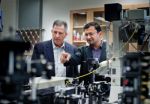(Press-News.org) Among patients with a severe, life-threatening type of sclerosis, treatment with hematopoietic stem cell transplantation (HSCT), compared to intravenous infusion of the chemotherapeutic drug cyclophosphamide, was associated with an increased treatment-related risk of death in the first year, but better long-term survival, according to a study in the June 25 issue of JAMA.
Systemic sclerosis is an autoimmune connective tissue disease characterized by vasculopathy (a disorder of the blood vessels), low-grade inflammation, and fibrosis (development of excess fibrous connective tissue) in skin and internal organs. Previously, small studies have shown that systemic sclerosis is responsive to treatment with autologous HSCT, although it has been unclear whether HSCT improves survival, according to background information in the article. For this study, autologous HSCT involved a multistep process beginning with infusion of high doses of cyclophosphamide and an antibody against immune cells, followed by reinfusion of the patient's own stem cells that had been previously collected from blood and purified.
Jacob M. van Laar, M.D., Ph.D., of the University Medical Center Utrecht, Utrecht, the Netherlands and Dominique Farge M.D., Ph.D, of the Assistance Publique - Hopitaux de Paris, Paris 7 Diderot University, France, and colleagues randomly assigned 156 patients with early diffuse cutaneous (widespread skin involvement) systemic sclerosis to receive HSCT (n = 79) or cyclophosphamide (n = 77; 12 monthly infusions). The phase 3 clinical trial was conducted in 10 countries at 29 centers; patients were recruited from March 2001 to October 2009 and followed up until October 2013.
During a median follow-up of 5.8 years, 53 adverse events occurred: 22 in the HSCT group (19 deaths and 3 irreversible organ failures) and 31 in the control group (23 deaths and 8 irreversible organ failures). Patients treated with HSCT experienced more adverse events (including death) in the first year but had better long-term event-free survival than those treated with cyclophosphamide.
Patients in the HCST group experienced higher mortality in the first year but had better long-term overall survival than those treated with cyclophosphamide. During year 1 there were 11 deaths (13.9 percent, including 8 treatment-related deaths) in the HSCT group vs 7 (9.1 percent, no treatment-related deaths) in the control group. After year 2 of follow-up, there were 12 deaths (15.2 percent) in the HSCT group vs 13 (16.9 percent) in the control group. After 4 years of follow-up, there were 13 deaths (16.5 percent) in the HSCT group vs 20 (26.0 percent) in the control group.
The authors add that HSCT was also more effective than intravenous cyclophosphamide on measures evaluating skin, functional ability, quality of life, and lung function, consistent with previous studies.
"Among patients with early diffuse cutaneous systemic sclerosis, HSCT was associated with increased treatment-related mortality in the first year after treatment. However, HCST conferred a significant long-term event-free survival benefit," the authors conclude.
INFORMATION:
(doi:10.1001/jama.2014.6368; Available pre-embargo to the media at http://media.jamanetwork.com)
Editor's Note: Please see the article for additional information, including other authors, author contributions and affiliations, financial disclosures, funding and support, etc.
Editorial: Autologous Hematopoietic Stem Cell Therapy in Severe Systemic Sclerosis
Ready for Clinical Practice?
In an accompanying editorial, Dinesh Khanna, M.D., M.Sc., of the University of Michigan, Ann Arbor, and colleagues provide suggestions on which patients should receive HSCT.
"Currently, consideration should be limited to patients with (1) diffuse cutaneous systemic sclerosis within the first 4 to 5 years of onset with mild-to-moderate internal organ involvement (severe internal organ involvement will make patients ineligible because of risks associated with HSCT) or (2) limited cutaneous systemic sclerosis with progressive internal organ involvement. This consideration also should generally be restricted to patients who have failed to improve or have worsened on conventional immunosuppressive agents and who are not active smokers; … Last, the cost-effectiveness of HSCT needs to be established, and multidisciplinary models of treatment decision making coupled with patient decision tools are needed. These approaches will provide a framework to evaluate and understand the trade-off between long-term benefits and short-term treatment-related morbidity and mortality of HSCT in patients with systemic sclerosis."
(doi:10.1001/jama.2014.6369; Available pre-embargo to the media at http://media.jamanetwork.com)
Editor's Note: Please see the article for additional information, including financial disclosures, funding and support, etc.
Stem cell transplantation for severe sclerosis associated with improved long-term survival
2014-06-24
ELSE PRESS RELEASES FROM THIS DATE:
3D mammography detects more invasive cancers and reduces call-back rates
2014-06-24
PHILADELPHIA—Reporting in the June 25 issue of JAMA, researchers from Penn Medicine and other institutions found that 3D mammography—known as digital breast tomosynthesis— found significantly more invasive, or potentially lethal, cancers than a traditional mammogram alone and reduced call-backs for additional imaging. This is the largest study reported to date—with nearly a half a million women—measuring the effectiveness of the technology, and could potentially lead to a change in the standard of care for breast screening.
"It's the most exciting improvement to mammography ...
3D Mammography finds more invasive cancers and reduces unnecessary recalls
2014-06-24
CLEVELAND – 3D Mammography finds significantly more invasive cancers and reduces unnecessary recalls, according to a large, retrospective study published in June 25 issue of the Journal of the American Medical Association (JAMA). The study features data from University Hospitals Case Medical Center Seidman Cancer Center.
The study, the largest of its kind, focused on the impact of 3D mammography at a diverse range of sites across the U.S, looking at nearly half a million mammograms at 13 sites.
Key Findings:
41% increase in invasive cancer detected with 3D mammography
15% ...
Chronic migraine has a substantial impact on marriage and parenting
2014-06-24
A web-based study of 994 men and women with chronic migraine found that the condition significantly impacts family relationships and activities, including cancelled vacation plans and reduced quality time with partners and children. Feelings of guilt, anger and annoyance toward family members due to headache, and avoidance of sexual intimacy due to headache also were reported. Chronic migraine is generally defined as migraine with headaches occurring 15 or more days per month.
The Family Burden of Chronic Migraine to the Migraineur: Results of the CaMEO (Chronic Migraine ...
Demonstrating a driverless future
2014-06-24
In the coming decades, we will likely commute to work and explore the countryside in autonomous, or driverless, cars capable of communicating with the roads they are traveling on. A convergence of technological innovations in embedded sensors, computer vision, artificial intelligence, control and automation, and computer processing power is making this feat a reality.
This week, researchers from Carnegie Mellon University (CMU) will mark a significant milestone, demonstrating one of the most advanced autonomous vehicles ever designed, capable of navigating on urban roads ...
Can coral save our oceans?
2014-06-24
Coral reefs are home to a rich and diverse ecosystem, providing a habitat for a wide range of marine animals. But the increasing acidification of ocean water is jeopardizing the calcified foundations of these reefs, endangering the survival of thousands upon thousands of resident species.
New research by Prof. Yehuda Benayahu, Dr. Zehava Barkay, Prof. Maoz Fine, and their jointly supervised graduate student Yasmin Gabay of Tel Aviv University's Department of Zoology, Wolfson Applied Materials Research Center and the Interuniversity Institute for Marine Sciences in Eilat ...
UT Arlington nanoparticles could provide easier route for cell therapy
2014-06-24
UT Arlington physics researchers may have developed a way to use laser technology to deliver drug and gene therapy at the cellular level without damaging surrounding tissue. The method eventually could help patients suffering from genetic conditions, cancers and neurological diseases.
In a study published recently by the journal Nature Scientific Reports, the team paired crystalline magnetic carbon nanoparticles and continuous wave near-infrared laser beams for in what is called photothermal delivery. Authors of the new paper are Ali Koymen, a professor of physics; Samarendra ...
How to protect an American wildlife legacy
2014-06-24
A new paper shows that while science plays a critical role in informing conservation action, scientists must move beyond the realm of their expertise into less familiar areas like public relations, education, and even politics, to ultimately meet America's conservation goals.
The paper, "Moving Beyond Science to Protect a Mammalian Migration Corridor," appears in the current online edition on the journal Conservation Biology, and will appear in Volume 28 of the print edition. Authors are Joel Berger of the Wildlife Conservation Society (WCS) and the University of Montana, ...
Group recommends removing sexual orientation-related disorders from the ICD
2014-06-24
A working group evaluating sexual orientation-related disorders listed in the International Classification of Diseases (ICD), a publication of the World Health Organization (WHO), has recommended the disorders be deleted, a move that will make getting health care easier for gays and others who may have gender atypicality.
The WHO is the world body charged with deciding what is a disease and more than 170 countries, including the United States, follow their recommendations. The organization is currently revising the 10th edition of the ICD for release of the 11th edition ...
UMMS scientists show that monarch butterflies employ a magnetic compass during migration
2014-06-24
WORCESTER, MA – Each fall millions of monarch butterflies use a sophisticated navigation system to transverse 2,000 miles from breeding sites across the eastern United States to an overwintering habitat in specific groves of fir trees in central Mexico. Scientists at the University of Massachusetts Medical School and Worcester Polytechnic Institute have identified a new component of this complex system. They reported in Nature Communications that monarchs use a light-dependent, inclination magnetic compass to help them orient southward during migration.
"Taken as a whole, ...
Cancer risks increase with complex heart tests
2014-06-24
Complex heart imaging can increase cancer risks for children throughout their lifetime, according to a new study co-authored by Le Bonheur Cardiologist Jason Johnson, MD, MHS. The study, which appears in the June 9, 2014 issue of the American Heart Association's journal Circulation, is the first in which researchers quantified cumulative radiation doses in pediatric heart patients and predicted lifetime cancer risks based on the types of exposures.
In the study, Johnson and fellow researchers found that radiation from standard X-rays don't significantly raise cancer risks ...




